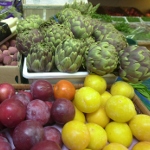You are here:
Health assessment of residues in foods

Foods may be rendered impure by residues or contaminants. Residues are the remains of substances which are intentionally used during the production of foods. They include, for instance, plant protection products and veterinary medicinal products.
Maximum levels are laid down for residues in the Maximum Levels of Residues Ordinance. Theses values are not based on medical or toxicological considerations but are oriented towards "good agricultural practice" as well as legal, social and political requirements. It is obvious that harmful values must not be exceeded in conjunction with maximum residue levels.
Contaminants are impurities with substances which are not used intentionally but which reach foods unintentionally. They may come from the environment or processing (e.g. nitrosamines in beer, dioxins and nitrosamines in smoked foods or grilled meat). Contaminants from the environment may be of natural original (mycotoxins in cereals or fruit juices) or have reached the environment as a consequence of human activity (PCBs, dioxins, heavy metals etc). The fundamental requirement of consumer health protection is to keep contaminants as far as possible to a minimum (minimisation requirement). However, the consumer can further reduce his uptake of residues and contaminants through his own behaviour (cf. document "Tips for Consumers").
Limit values or maximum levels create binding regulations concerning the contamination of foods with residues or contaminants.
Maximum levels - Limit values - Intervention values - Guidance values: How are they laid down?
Maximum levels, limit values, intervention values or guidance values are all conventions. That means that they are not solely based on toxicological considerations. The toxicological assessment of a substance does, however, constitute the external framework within which values of this kind are laid down for consumer health protection.
Food monitoring and the Residue Monitoring Plan provide an overview of the contamination of foods with residues and contaminants in Germany (external links see below).
Information
(3)| Date | Title | Size |
|---|---|---|
|
23.03.2011 BfR Information Nr. 011/2011
|
Breast milk: Dioxin concentrations decrease continually |
28.8 KB
|
|
15.02.2010 BfR Information Nr. 019/2010
|
Residues of veterinary medicinal products in foods of plant origin |
30.5 KB
|
|
18.03.2009 BfR Information No. 006/2009 concerning a study by the University Frankfurt am Main
|
Substances with hormone-like activity in mineral water from PET bottles |
67.7 KB
|
Opinion
(57)Other documents
(8)Press releases
(17)Communication
(5)| Date | Title | Size |
|---|---|---|
|
11.04.2023 Updated Communication No. 016/2023
|
Nitrosamines in food: EFSA publishes new opinion on health risks |
52.8 KB
|
|
02.03.2020 BfR Opinion No 013/2020
|
Shooting with lead on gelatine and soap |
169.3 KB
|
|
03.12.2018 BfR Communication No 037/2018
|
Non-dioxin-like PCBs are undesirable in food and feed |
193.0 KB
|
|
20.11.2018 BfR Communication No 036/2018
|
European Food Safety Authority (EFSA) proposes new health-based guidance value for dioxins and dioxin-like polychlorinated biphenyls |
145.4 KB
|
|
29.10.2018 BfR Communication No 033/2018
|
Is there a risk to human health from microplastics? More research and scientific data needed |
112.6 KB
|
